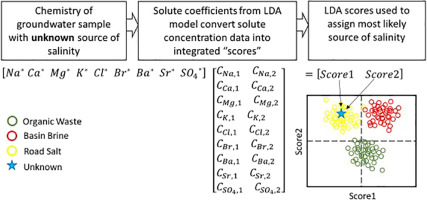Science of the Total Environment ( IF 8.2 ) Pub Date : 2017-11-10 , DOI: 10.1016/j.scitotenv.2017.11.019 Nathaniel P. Chien , Laura K. Lautz

|
Concern over contamination of groundwater resources in areas impacted by anthropogenic activities has led to an increasing number of baseline groundwater quality surveys intended to provide context for interpreting water quality data. Flexible screening tools that can parse through these large, regional datasets to identify spatial or temporal changes in water quality are becoming more important to groundwater scientists. One such tool, developed from previous work by the authors, makes use of linear discriminant analysis (LDA) to identify the most probable source of chloride salinity in groundwater samples based on their geochemical fingerprints. Here, we applied the model to a dataset of shallow groundwater with known sources of contamination compiled from two studies of groundwater quality in Illinois: Panno et al. (2005) and Hwang et al. (2015). By predicting the source of salinity in groundwater samples for which the sources of contamination are known, we validated model prediction-accuracy. Results show high classification accuracy for groundwater samples impacted by basin brines (e.g. deep saline groundwater) and road salt (> 80%), with diminishing success for those impacted by organic sources of chloride, such as septic effluent and animal waste. Posterior probabilities, a statistic inherent to LDA, provide a proxy for prediction confidence that enables the model to be used for assessment and accountability measures, such as identifying parties responsible for contamination. LDA is complementary to fingerprinting using halogen ratios (e.g. Cl/Br) because it implicitly relies on halogen ratios for classification decisions while providing a clearer, more quantitative classification of contamination sources. Our model is ideal for regional assessment or initial screening of salinity sources in groundwater because it makes use of commonly measured solute concentrations in publicly available water quality databases.
中文翻译:

判别分析作为地下水盐分地球化学指纹识别的决策工具
由于人为活动影响的地区对地下水资源的污染引起关注,导致基线地下水质量调查数量不断增加,旨在为解释水质数据提供背景。灵活的筛选工具可以解析这些大型的区域数据集,以识别水质的时空变化,这对地下水科学家而言变得越来越重要。作者从以前的工作中开发出了一种这样的工具,它利用线性判别分析(LDA)根据地球化学指纹识别地下水样品中最可能的氯化物盐分来源。在这里,我们将模型应用到具有已知污染源的浅层地下水数据集,该数据集来自伊利诺伊州的两项地下水质量研究:Panno等。(2005)和Hwang等。(2015)。通过预测已知污染源的地下水样品中的盐度来源,我们验证了模型的预测准确性。结果表明,受流域盐水(例如深盐地下水)和道路盐(> 80%)影响的地下水样品的分类准确度高,而对受有机氯离子源(例如化粪池污水和动物粪便)影响的样品的成功率却下降。后验概率(LDA固有的统计数据)提供了预测置信度的代理,使模型可以用于评估和问责措施,例如确定造成污染的各方。LDA是使用卤素比率(例如Cl / Br)进行指纹识别的补充,因为它隐含地依赖卤素比率进行分类决策,同时提供了更清晰的信息,更定量地分类污染源。我们的模型非常适合用于区域评估或初步筛选地下水中的盐分源,因为它利用了公开提供的水质数据库中通常测量的溶质浓度。











































 京公网安备 11010802027423号
京公网安备 11010802027423号